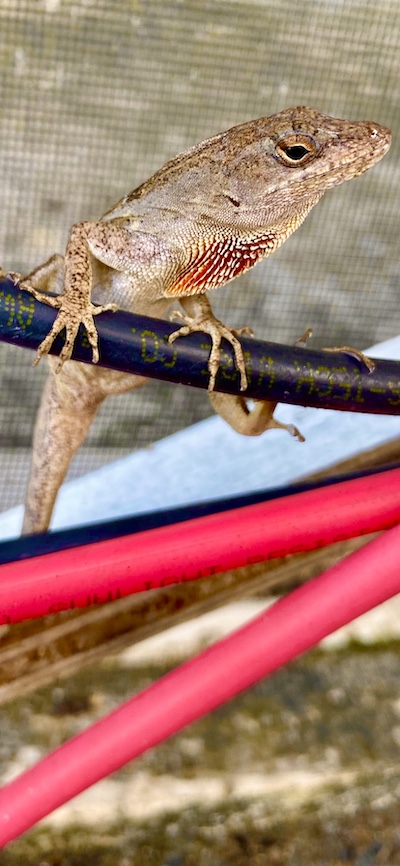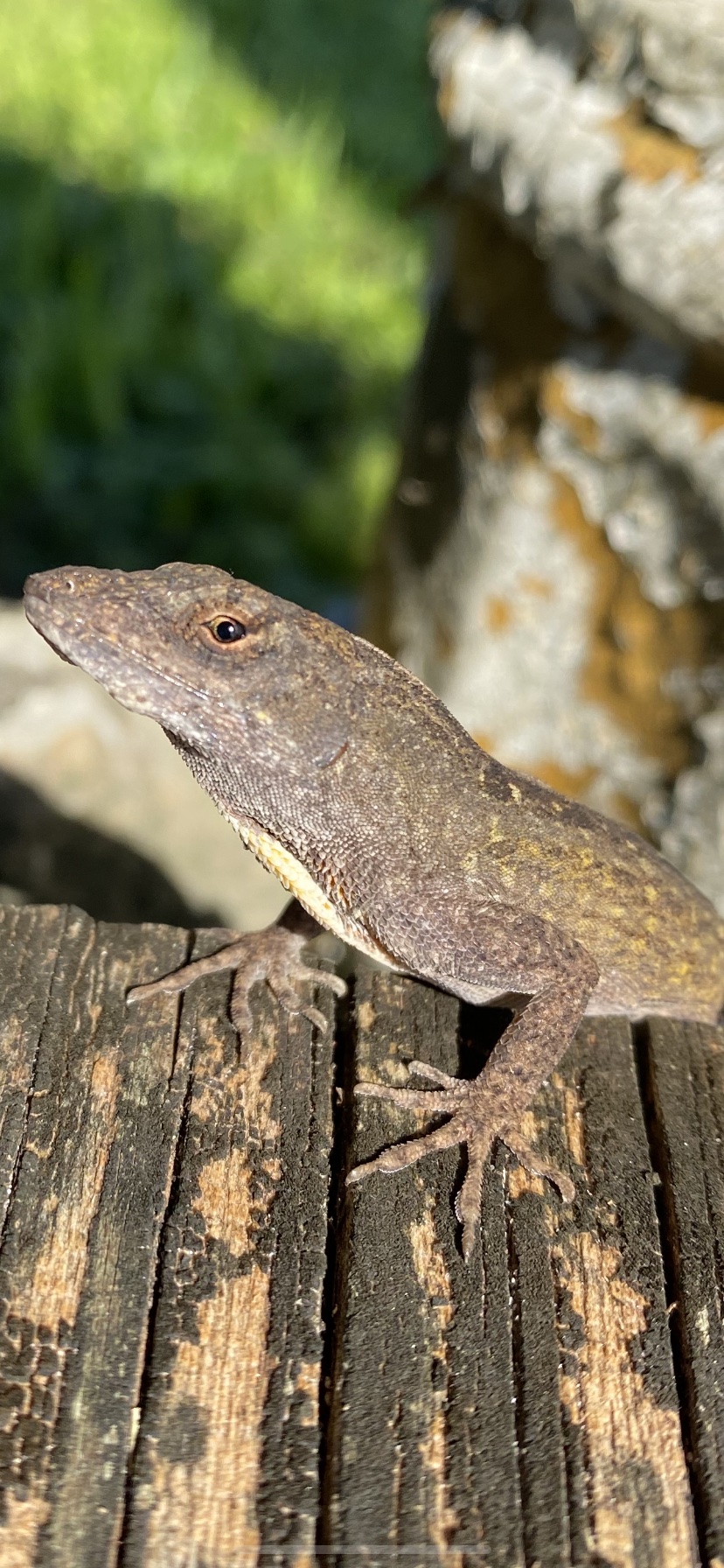Brownie
For an afternoon this Sunday, I thought Brownie was dying.
To make a long story short, Brownie was doing just fine–in the end. My tears over Brownie’s demise would have seemed an exaggeration to outside observers anyway. Brownie is a five-inch-long (counting his tail), very common lizard, and brown, as the name I gave him implies. He belongs to the dominant lizard species on our property here on the edge of the Everglades. They are called brown anoles (which I learned after I had named him Brownie) and found their way to South Florida from Cuba and other Caribbean islands. There are thousands of Brownie brothers and sisters teeming everywhere here. They are part of the landscape.
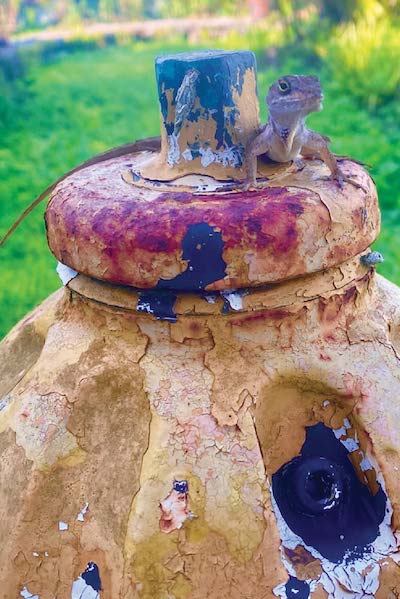 Here is why Brownie is special to me. Starting about six months ago, I noticed him for the first time on the tip of the yellow hydrant next to the stoop in front of the concrete stairs that lead up to the second-floor veranda of the house. We do not have municipal water here. An electric pump gets our water from a well in the back of the house. Therefore, the hydrant is not connected to anything. Then again, you could say it has a connection to the past–because of Wayne. Wayne is one of the three previous owners of this property. He was a retired fireman who brought the hydrant as a souvenir from his job. Maybe his colleagues gave it to him as a farewell present. Wayne’s wife was Patty. They lived here for ten years. There is a little ramp on the north side of the house by the Happy Tree that has Patty’s name engraved in concrete. It says “Patty’s Parking.” It is poignant. Wayne and Patty are long since dead.
Here is why Brownie is special to me. Starting about six months ago, I noticed him for the first time on the tip of the yellow hydrant next to the stoop in front of the concrete stairs that lead up to the second-floor veranda of the house. We do not have municipal water here. An electric pump gets our water from a well in the back of the house. Therefore, the hydrant is not connected to anything. Then again, you could say it has a connection to the past–because of Wayne. Wayne is one of the three previous owners of this property. He was a retired fireman who brought the hydrant as a souvenir from his job. Maybe his colleagues gave it to him as a farewell present. Wayne’s wife was Patty. They lived here for ten years. There is a little ramp on the north side of the house by the Happy Tree that has Patty’s name engraved in concrete. It says “Patty’s Parking.” It is poignant. Wayne and Patty are long since dead.
At any rate, Brownie caught my eye because a) I would see him on top of the hydrant almost every day, and b) he was unusually calm when I sat down on the stoop to chat him up. I know, I have a way of emotionally attaching myself to animals if they keep showing up in the same places. It happened with Baby Hawk a couple of years ago (and led to a farm story). It seemed like it was happening again with Brownie. A cynic might say that Brownie was the new Baby Hawk.
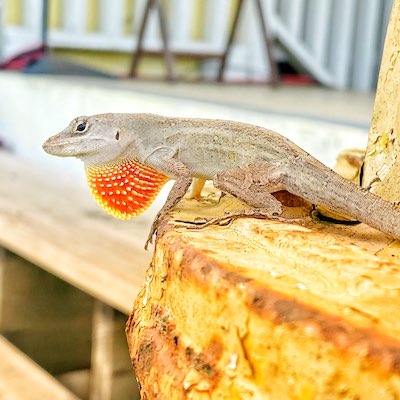 In June, I went on my first trip in more than three years to see my parents in Germany. While on the island in the North Sea where they live, I got Covid and gave it to them (it was all mild, thank goodness). During that time, I often thought of Brownie, a lizard almost 5,000 miles away in the Everglades. As I was riding one of my parents’ bikes through the “Grünstreifen,” which means “Green Stripe” and is a beautiful sliver of forest running through parts of the island, I wondered if Brownie was sitting on top of the hydrant. I asked myself if he was bobbing his head and extending his dewlap, a thin piece of reddish skin he can unfold like a blade from underneath his neck. I wondered if he would still be there on my return. What life expectancy does a brown anole have anyway?
In June, I went on my first trip in more than three years to see my parents in Germany. While on the island in the North Sea where they live, I got Covid and gave it to them (it was all mild, thank goodness). During that time, I often thought of Brownie, a lizard almost 5,000 miles away in the Everglades. As I was riding one of my parents’ bikes through the “Grünstreifen,” which means “Green Stripe” and is a beautiful sliver of forest running through parts of the island, I wondered if Brownie was sitting on top of the hydrant. I asked myself if he was bobbing his head and extending his dewlap, a thin piece of reddish skin he can unfold like a blade from underneath his neck. I wondered if he would still be there on my return. What life expectancy does a brown anole have anyway?
I extended the stay with my parents for a week to make up for the time we lost dealing with our infections. After returning to the Everglades, I was delighted to see Brownie on the hydrant again. Like I did with Baby Hawk, I continued the habit of sitting down with him every afternoon, enjoying the time together and the frequent eye contact. I knew Brownie was a “he” because I frequently saw him copulating with smaller females, helping ensure the dominance of the local brown anole population. He had gotten so used to me that he let me take close-up pictures during the act (the female seemed a bit more concerned). I felt privileged. I also saw him poop once, the first time I saw a lizard poop. Brownie gave me a front-row seat to all of it.
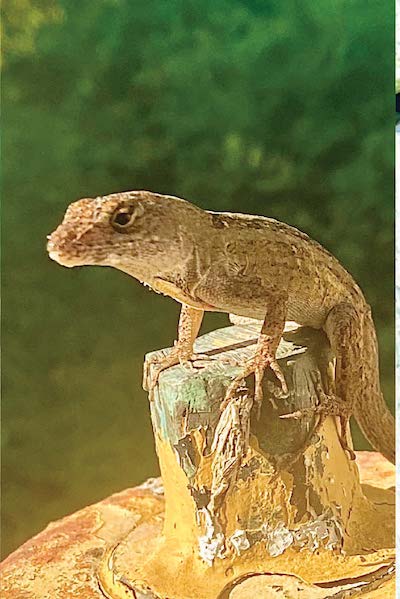 My favorite pictures, however, were the ones I took of him towering on the hydrant in various “king of the world” poses. He would let me get within an inch of him with my iPhone to take the pictures. A couple of times, he let me touch his tail, and would not run away. Yesterday, he, for the first time, let me touch his nose, ever so briefly and gently, with my index finger. And he stayed.
My favorite pictures, however, were the ones I took of him towering on the hydrant in various “king of the world” poses. He would let me get within an inch of him with my iPhone to take the pictures. A couple of times, he let me touch his tail, and would not run away. Yesterday, he, for the first time, let me touch his nose, ever so briefly and gently, with my index finger. And he stayed.
As I mentioned, on Sunday, I believed Brownie was dying. The previous day the American President had talked about his worries regarding “Armageddon” in a conversation with Democratic donors. I bought and filled up four extra canisters of gasoline and 200 cans of tuna fish from Aldi that morning–in case the world might end. So I was in an already apocalyptic mindset when I found a brown anole clinging listlessly to the inside of the screening of the patio area downstairs. For some reason, I immediately concluded that it was Brownie, even though I remember thinking that this anole seemed crinkled and shrunk. I thought that maybe it was part of the dying process. When I touched the lizard who I believed was Brownie he would barely move, briefly open his eyes, and then slowly close them again. I could see him breathe. It was heart-wrenching and made me cry. I kneeled next to him, thanked him for the times together, and said my good-byes.
I resolved that I should let Brownie die in peace rather than stress him with caresses during his final hours. As I went about my day, I would glance at him from a distance, spotting his static shape with a heavy heart. I resolved that I would give Brownie a proper burial and got a little carton box that I had kept in the glove compartment of my car, containing sanitary gloves to wear when filling up on gas. The box was going to be Brownie’s coffin.
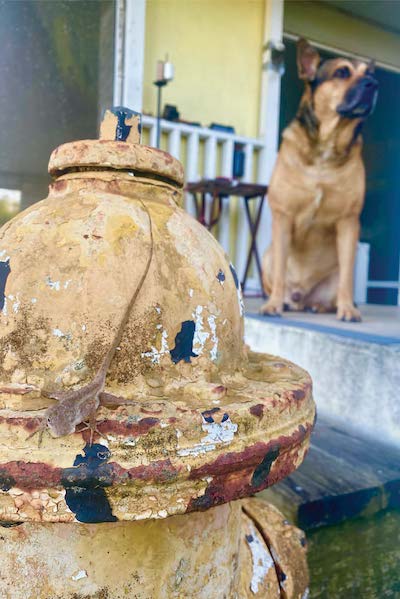
Brownie and Zeus
Like I said, long story short, later that day, I saw the real Brownie back on top of the hydrant, bobbing his head and showing off his dewlap. I felt a dizzying sense of relief. I immediately called David to let him know the good news. The other lizard, the one I thought was Brownie, continued to cling to the patio screen. I still felt bad for him, but it was not the same anymore. David asked, “what happened to your compassion for the dying one?”
The following morning, the dying lizard was not on the screen anymore. I looked around, afraid to find his body on the patio floor. But I didn’t see him there. Later that day, he reappeared on a different spot of the patio screen, again, barely moving but still breathing. Maybe he was not dying but dealing with an erroneous onset of brumation, which, I learned from Wikipedia, is like hibernation for lizards.
Looking for him now as I write this, he has moved on again, nowhere to be seen.

